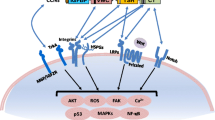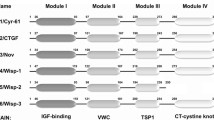Abstract
CCN5, a member of the CCN family of growth factors, inhibits the proliferation and migration of smooth muscle cells in cell culture and animal models. Expressed in both embryonic and adult tissues, CCN5 exhibits a matricellular localization pattern characteristic of secreted proteins that are closely associated with the cell surface. In addition to this observed expression pattern, immunohistochemical evidence suggests the presence of nuclear CCN5 in some cells. To determine if CCN5 localizes to the nucleus we performed immunofluorescence, confocal imaging, and cell fractionation to corroborate the immunohistochemical observations. After confirming the presence of nuclear CCN5 using four independent experimental methods, we identified a single putative nuclear localization signal in the von Willebrand factor C domain of mouse and rat CCN5. Site directed mutagenesis of the three basic amino acids in the putative nuclear localization sequence did not prevent nuclear localization of CCN5 in four different cell types, suggesting that CCN5 nuclear transport is not mediated by the only canonical nuclear localization signal present in the primary amino acid sequence. Future work will address the mechanism of nuclear localization and the function of nuclear versus secreted CCN5.






Similar content being viewed by others
Abbreviations
- (CT):
-
Carboxy terminal domain
- (CCN):
-
cysteine rich 61/connective tissue growth factor/nephroblastoma overexpressed
- (GFP):
-
green fluorescent protein
- (hAoSMC):
-
human aortic smooth muscle cells
- (IGFBP):
-
insulin-like growth factor-binding protein domain
- (NLS):
-
nuclear localization signal(s)
- (SMC):
-
smooth muscle cell
- (TSP-1):
-
thrombospondin-1 domain
- (VSMC):
-
vascular smooth muscle cells
- (VWC):
-
von Willebrand Factor-C domain
References
Castellot JJ Jr, Favreau LV, Karnovsky MJ, Rosenberg RD (1982) Inhibition of vascular smooth muscle cell growth by endothelial cell-derived heparin. Possible role of a platelet endoglycosidase. J Biol Chem 257(19):11256–11260
Cervello M, Giannitrapani L, Labbozzetta M, Notarbartolo M, D’Alessandro N, Lampiasi N, Azzolina A, Montalto G (2004) Expression of WISPs and of their novel alternative variants in human hepatocellular carcinoma cells. Ann NY Acad Sci 1028:432–439
Delmolino LM, Stearns NA, Castellot JJ Jr (2001) COP-1, a member of the CCN family, is a heparin-induced growth arrest specific gene in vascular smooth muscle cells. J Cell Physiol 188(1):45–55
Gray MR, Malmquist JA, Sullivan M, Blea M, Castellot JJ Jr (2007) CCN5 Expression in mammals. II. Adult rodent tissues. J Cell Commun Signal 1(2):145–158
Horton P, Nakai K (1997) Better prediction of protein cellular localization sites with the k nearest neighbors classifier. Proc Int Conf Intell Syst Mol Biol 5:147–152
Jones JA, Gray MR, Oliveira BE, Koch M, Castellot JJ Jr (2007) CCN5 expression in mammals: I. Embryonic and fetal tissues of mouse and human. J Cell Commun Signal 1(2):127–143
Lake AC, Castellot JJ Jr (2003) CCN5 modulates the antiproliferative effect of heparin and regulates cell motility in vascular smooth muscle cells. Cell Commun Signal 1(1):5
Lake AC, Bialik A, Walsh K, Castellot JJ Jr (2003) CCN5 is a growth arrest-specific gene that regulates smooth muscle cell proliferation and motility. Am J Pathol 162(1):219–231
Lee DK, Lanca AJ, Cheng R, Nguyen T, Ji XD, Gobeil F Jr, Chemtob S, George SR, O’Dowd BF (2004) Agonist-independent nuclear localization of the Apelin, angiotensin AT1, and bradykinin B2 receptors. J Biol Chem 279(9):7901–7908
Mason HR, Nowak RA, Morton CC, Castellot JJ Jr (2003) Heparin inhibits the motility and proliferation of human myometrial and leiomyoma smooth muscle cells. Am J Pathol 162(6):1895–1904
Perbal B (1999) Nuclear localisation of NOVH protein: a potential role for NOV in the regulation of gene expression. Mol Pathol 52(2):84–91
Planque N (2006) Nuclear trafficking of secreted factors and cell-surface receptors: new pathways to regulate cell proliferation and differentiation, and involvement in cancers. Cell Commun Signal 4:7
Planque N, Perbal B (2003) A structural approach to the role of CCN (CYR61/CTGF/NOV) proteins in tumourigenesis. Cancer Cell Int 3(1):15
Planque N, Long Li C, Saule S, Bleau AM, Perbal B (2006) Nuclear addressing provides a clue for the transforming activity of amino-truncated CCN3 proteins. J Cell Biochem 99(1):105–116
Tamura I, Rosenbloom J, Macarak E, Chaqour B (2001) Regulation of Cyr61 gene expression by mechanical stretch through multiple signaling pathways. Am J Physiol Cell Physiol 281(5):C1524–C1532
Thakur S, Zhang HB, Peng Y, Le H, Carroll B, Ward T, Yao J, Farid LM, Couch FJ, Wilson RB, Weber BL (1997) Localization of BRCA1 and a splice variant identifies the nuclear localization signal. Mol Cell Biol 17(1):444–452
Wahab NA, Brinkman H, Mason RM (2001) Uptake and intracellular transport of the connective tissue growth factor: a potential mode of action. Biochem J 359(Pt 1):89–97
Wei L, McKeon F, Russo JW, Lemire J, Castellot J (2009) Domain-and species-specific monoclonal antibodies recognize the Von Willebrand Factor-C domain of CCN5. J Cell Commun Signal 3(1):65–77
Acknowledgments
This paper is dedicated to the memory of Mark Gray. The work was support in part by grants HD046251 and HL49973 to JJC and an American Heart Association Fellowship to CB.
Author information
Authors and Affiliations
Corresponding author
Rights and permissions
About this article
Cite this article
Wiesman, K.C., Wei, L., Baughman, C. et al. CCN5, a secreted protein, localizes to the nucleus. J. Cell Commun. Signal. 4, 91–98 (2010). https://doi.org/10.1007/s12079-010-0087-x
Received:
Accepted:
Published:
Issue Date:
DOI: https://doi.org/10.1007/s12079-010-0087-x




